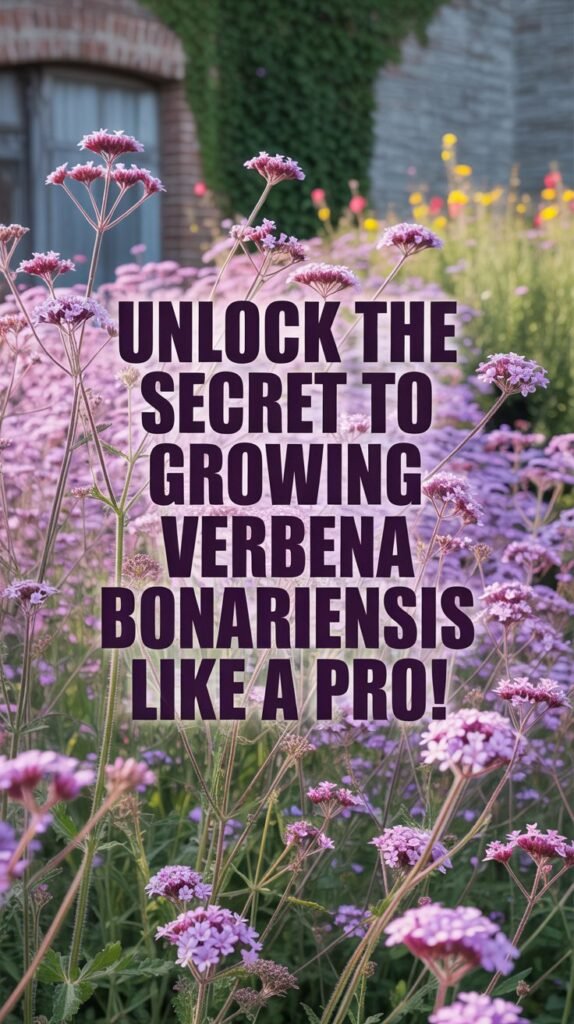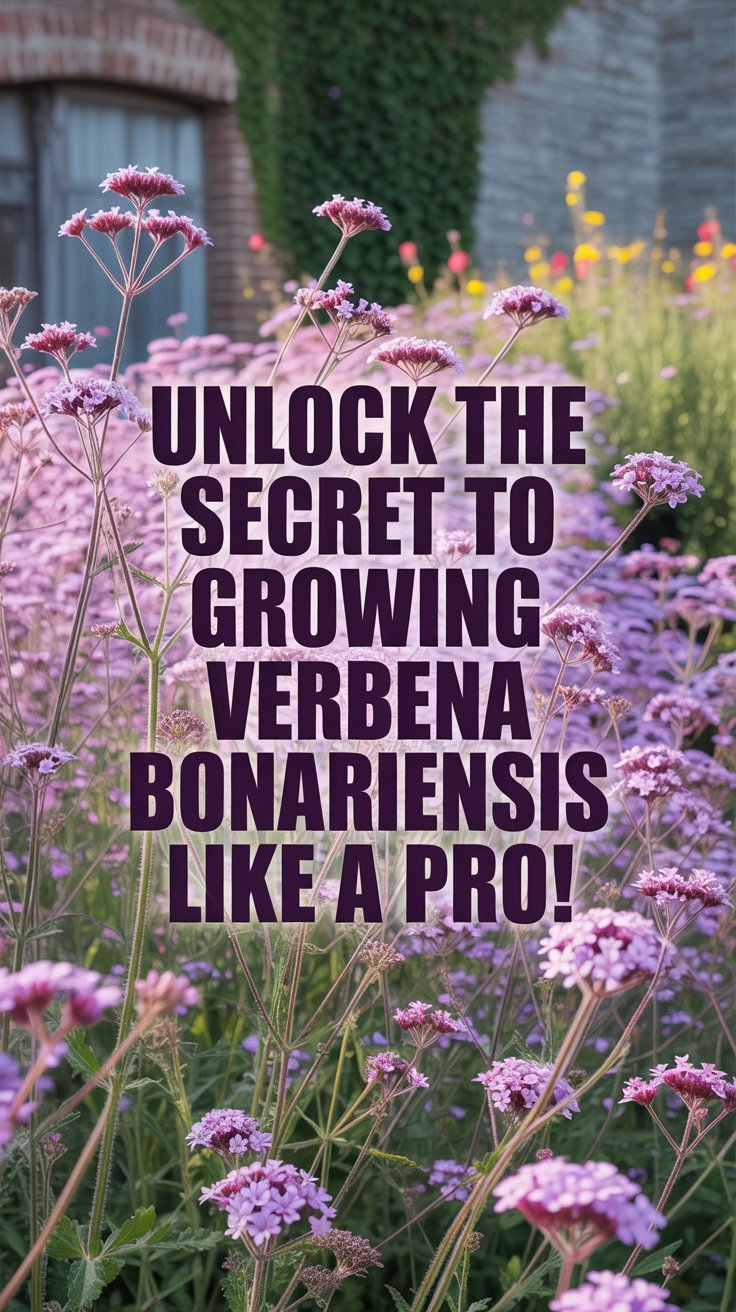Want to master growing Verbena Bonariensis? Discover 6 key tips on planting, care, and more to enjoy this butterfly-friendly beauty in your garden!

Hey there, fellow gardeners! I’m Ashley Scott, and with over 10 years of gardening experience under my belt, I’ve grown just about everything you can imagine. Today, I’m thrilled to dive into one of my all-time favorites: Growing Verbena Bonariensis. If you’ve ever seen those tall, wispy stems topped with clusters of tiny purple flowers swaying in the breeze, you know why this plant is a showstopper. Not only does it bring height and color to your garden, but it’s also a butterfly magnet—perfect for anyone looking to create a pollinator-friendly space. Want more tips on attracting butterflies? Check out my guide on Butterfly Buffets Gardening over at USA Garden Hub.
In this article, I’ll walk you through 6 Things – Growing Verbena Bonariensis that every gardener needs to know. From planting to care, I’ve got you covered with practical advice, personal stories, and expert tips to help you succeed. Whether you’re a newbie or a seasoned pro, you’ll find everything you need to make this gorgeous plant thrive in your backyard. So, grab your gardening gloves, and let’s get started!
1. What Makes Verbena Bonariensis Special?
Let’s kick things off with the basics. Verbena Bonariensis, sometimes called purpletop vervain or tall verbena, is a South American native that’s found a home in gardens across the USA. It’s a tall drink of water—reaching up to 6 feet—with slender stems and clusters of vibrant purple flowers that bloom from mid-summer to fall. What I love most? Its airy structure. The sparse leaves let light peek through, making it a perfect addition to borders without hogging the spotlight.
Why grow it? For starters, it’s a pollinator powerhouse. Butterflies and bees can’t resist its nectar-rich blooms. Plus, it’s low-maintenance, drought-tolerant, and even self-seeds in the right conditions. I first fell for it when I saw it dancing in a friend’s garden, and I’ve been hooked ever since. It’s also super versatile—great in beds, pots, or as a cut flower. Curious about other perennials? Pop over to my Perennial Flowers page for more inspiration.
2. Planting Verbena Bonariensis: Seeds, Cuttings, or Pots?
Getting Verbena Bonariensis started is easier than you might think. Here’s how I’ve done it over the years:
Growing Verbena Bonariensis from Seed
Seeds are my go-to because they’re affordable and reliable. You can start them indoors or sow them straight in the garden. For growing Verbena Bonariensis from seed indoors, begin 8-12 weeks before your last frost. Use a seed-starting mix, press the seeds lightly into the surface (they need light to sprout), and keep them moist at about 70°F. They’ll pop up in 14-21 days. Once they’ve got a couple of leaves, pot them up and harden them off before planting outside. Outdoors, scatter seeds after the frost in a sunny spot and keep the soil damp. Need more seed-starting tricks? My Seed Starting Guide has you covered.
Growing Verbena Bonariensis from Cuttings
Got a healthy plant already? Try growing Verbena Bonariensis from cuttings. In late spring, snip 4-6 inch pieces from non-flowering stems, strip the lower leaves, dip in rooting hormone, and plant in a perlite-peat mix. Keep them moist in bright, indirect light—they’ll root in a few weeks. I once saved a favorite plant this way, and it felt like a gardening win!
Growing Verbena Bonariensis in Pots
For small spaces, growing Verbena Bonariensis in pots is a dream. Use a 12-inch pot with drainage holes, fill it with a well-draining mix (think peat, perlite, and compost), and place it in full sun. I’ve got a few on my patio with lavender, and the combo is pure magic.
3. Perfect Growing Conditions for Verbena Bonariensis
To keep your Verbena happy, nail these growing conditions for Verbena Bonariensis:
- Soil: It loves well-drained soil with a pH of 6.0-7.0. It’ll tolerate poor soil, but I mix in compost for a boost. My sandy loam works wonders, though clay needs amending.
- Sunlight: Full sun is non-negotiable—6-8 hours daily. I learned this the hard way when a shady spot left mine leggy and bloom-shy.
- Water: It’s drought-tolerant once settled, but regular watering helps it thrive. I water mine weekly in summer, letting the soil dry between sessions. Overwatering? Big no-no—root rot city.
The Wisconsin Horticulture Extension confirms these basics, noting its love for light and drainage.
4. How to Care for Verbena Bonariensis
Once it’s growing, a little TLC goes a long way. Here’s how to care for Verbena Bonariensis:
How to Support Verbena Bonariensis
Those tall stems can flop in the wind. I plant mine behind sturdy salvia or use stakes if needed. A sheltered spot works too—less wind, less fuss.
Deadheading
Snip off faded blooms to keep the flowers coming. I do this every couple of weeks, and it keeps my plants tidy and blooming longer. Bonus: it curbs over-seeding.
Overwintering
In zones 7-11, it’s a perennial (yay!). In colder areas, mulch the base in fall or treat it as an annual. Last year, I mulched mine in zone 6, and it surprised me by bouncing back.
BBC Gardeners World Magazine agrees—full sun and minimal fuss are key .
5. Propagating Verbena Bonariensis
Love it so much you want more? Propagation is a breeze.
- Seeds: Let some flowers dry on the plant, then collect the brown seeds in a paper bag. Store them cool and dry. I’ve shared handfuls with neighbors this way.
- Cuttings: As I mentioned, spring cuttings root fast. I’ve even rooted some in water just to watch the magic happen.
Proven Winners has great propagation tips if you want a deeper dive .
6. Troubleshooting Common Verbena Bonariensis Issues
Even easy plants have hiccups. Here’s what I’ve run into:
- Powdery Mildew: Humid weather can bring this white coating. Space plants for airflow, water at the base, and use a baking soda spray if it hits. Rare for me, but it happens.
- Leggy Growth: Too little sun makes it stretch. I moved a sad specimen to full sun, and it transformed.
The University of Maryland Extension has solid advice on mildew prevention .
Bonus: Companion Planting Ideas
Verbena Bonariensis shines with friends. I pair mine with ornamental grasses like Miscanthus for texture, or rudbeckia for a yellow-purple pop. Echinacea and salvia work too—my garden’s a pollinator party!
Wrapping Up
There you have it—6 Things – Growing Verbena Bonariensis to make your garden glow. From its pollinator appeal to its easy-care vibe, this plant’s a winner. Whether you’re sowing seeds, potting it up, or just keeping it happy, these tips (and a decade of my trial-and-error) will set you up for success. So, give it a try—I promise it’ll become a favorite in no time!
FAQs
Is Verbena Bonariensis a perennial?
Yes, in zones 7-11. Elsewhere, it’s an annual unless you protect it.
How long does Verbena Bonariensis take to grow?
Seeds sprout in 14-21 days; blooms come in a few months.
How quickly does Verbena Bonariensis grow?
Pretty fast—expect flowers in its first season.
Can I grow Verbena Bonariensis in pots?
You bet! Just ensure sun and drainage.
What’s the Verbena Bonariensis growing zone?
Thrives as a perennial in 7-11, annual elsewhere.
Low-growing Verbena Bonariensis—does it exist?
Not really—it’s naturally tall, but pruning can control height.
For more plant care wisdom, Cornell University’s gardening site is gold .




